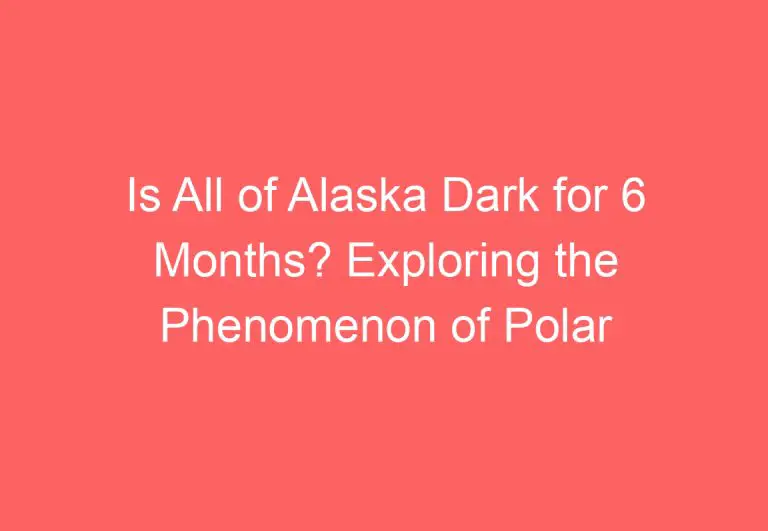Why Alaska Experiences 30 Days of Night: A Clear Explanation
Alaska is known for many things, including its vast wilderness, stunning landscapes, and unique natural phenomena. One of the most fascinating phenomena that Alaska experiences is the 30 days of night. This period of total darkness lasting for more than 24 hours is known as the polar night and is a truly unique phenomenon that few people will ever experience.

The polar night exists north of the Arctic Circle, where few inhabitants live year-round. In fact, the northernmost city in America, Utqiaġvik (formerly known as Barrow), has near-constant darkness from mid to late November until late January because the sun never rises during that 60-plus-day period. This phenomenon is not limited to Utqiaġvik, as much of Alaska experiences a significant reduction in daylight hours during the winter months.
Alaskans have adapted to the polar night by coping with the nearly all-day darkness in various ways. For instance, they use artificial light to simulate daylight, and some even take Vitamin D supplements to make up for the lack of sunlight. Despite the challenges of the polar night, many Alaskans embrace the winter months and enjoy outdoor activities such as skiing, snowmobiling, and ice fishing.
Phenomenon of Extended Darkness

Alaska is known for its prolonged periods of darkness during the winter season. The phenomenon of extended darkness is caused by a combination of geographic and astronomical factors.
Geographic and Astronomical Factors
The Earth’s axial tilt and rotation around the sun are the primary astronomical factors that contribute to Alaska’s extended periods of darkness. During the winter season, the Earth’s axial tilt causes the Northern Hemisphere to tilt away from the sun, resulting in fewer daylight hours. Alaska’s location at a high latitude, near the Arctic Circle, also contributes to its prolonged periods of darkness during the winter season.
Polar Night and Its Duration
The polar night is a natural phenomenon that occurs in regions near the Earth’s poles. During the polar night, the sun remains below the horizon for an extended period, resulting in complete darkness. In Alaska, the polar night lasts for approximately 30 days in some regions, such as Utqiaġvik (formerly known as Barrow), which is the northernmost city in the United States.
During the polar night, there are different stages of darkness, including civil twilight, nautical twilight, and astronomical twilight. Civil twilight is the period when the sun is just below the horizon, but there is still enough light to see objects clearly. Nautical twilight occurs when the sun is 6 to 12 degrees below the horizon, and there is still some light available for navigation. Astronomical twilight is the period when the sun is between 12 and 18 degrees below the horizon, and it is too dark for most activities.
Overall, the phenomenon of extended darkness in Alaska is a natural occurrence caused by a combination of geographic and astronomical factors. While it may be challenging for some to adjust to the extended periods of darkness, it is an essential aspect of the winter season in Alaska.
Impact on Life in Alaska

Adjustments in Daily Activities
The 30 days of night in Alaska can have a significant impact on the daily activities of locals and visitors. With little to no sunlight, people have to adjust their schedules to make the most of the limited daylight hours. In some parts of Alaska, the sun may not rise at all, which can lead to sleep disturbances and affect one’s overall mood.
To cope with the darkness, Alaskans often use blackout curtains to keep their homes dark during the day and light during the night. They also tend to conserve energy by reducing their electricity usage. During the polar night, people often engage in indoor activities such as reading, watching movies, or playing board games.
Cultural and Social Adaptations
The 30 days of night in Alaska have also led to cultural and social adaptations. For example, some communities in Alaska organize events such as dance parties and festivals to boost morale during the long nights. The Northern Lights, a natural phenomenon that is more visible during the polar night, also attracts tourists and locals alike.
Alaskans are known for their love of the outdoors, and many still engage in outdoor activities during the polar night, such as ice fishing and hiking. The darkness also affects the produce available during the winter months, which can lead to a greater reliance on imported goods.
Economic and Ecological Effects
The 30 days of night in Alaska can have both economic and ecological effects. For example, the darkness can limit travel and tourism, leading to a decrease in revenue for businesses that rely on tourism. In addition, the polar night can impact the mental health of locals, leading to increased healthcare costs.
On the other hand, the polar night can also have ecological benefits. The darkness can help regulate the temperature in the Arctic region, which can have a positive impact on the ecosystem. The polar night can also lead to greater visibility of the Northern Lights, which can attract more tourists to the region.
Overall, the 30 days of night in Alaska have a significant impact on the lives of Alaskans and visitors to the state. While it can lead to adjustments in daily activities and cultural adaptations, it can also have economic and ecological effects.
Frequently Asked Questions

What causes the extended periods of darkness in Alaska during winter?
The extended periods of darkness in Alaska during winter are caused by the tilt of the Earth’s axis. During winter, the North Pole is tilted away from the sun, which causes the sun’s rays to hit the Earth at an angle, resulting in less daylight hours for Alaska and other northern regions.
How long does the ‘night’ last in places like Barrow, Alaska?
In places like Barrow, Alaska, the ‘night’ can last for up to 67 days during the winter months. This period is known as the polar night, and it occurs when the sun remains below the horizon for an extended period.
During which months does Alaska experience continuous daylight?
Alaska experiences continuous daylight during the summer months, typically from late May to late July. This period is known as the midnight sun, and it occurs when the sun remains above the horizon for an extended period.
What is the duration of the polar night in Alaska?
The duration of the polar night in Alaska varies depending on the location. In Barrow, the polar night can last for up to 67 days, while in Anchorage, the polar night lasts for around 19 hours.
Is it true that certain areas in Alaska are dark for six months?
No, it is not true that certain areas in Alaska are dark for six months. While some areas in Alaska experience extended periods of darkness during the winter months, no location in Alaska experiences complete darkness for six months.
How does the phenomenon of 24 hours of darkness affect life in Alaska?
The phenomenon of 24 hours of darkness can have a significant impact on life in Alaska, particularly in areas that experience the polar night. During this period, residents may struggle with depression, sleep disturbances, and other health issues. Additionally, the lack of sunlight can impact agriculture, wildlife, and other aspects of daily life.






